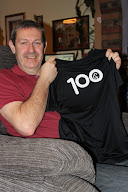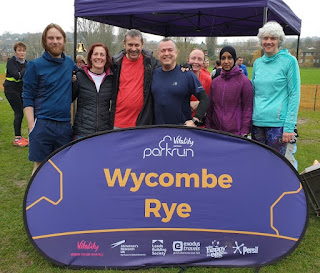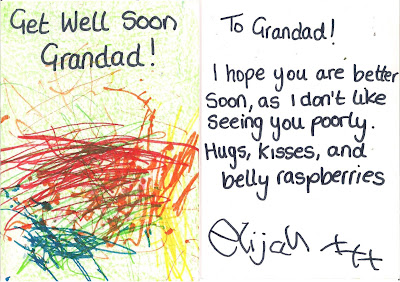Heart Attack to 10K (part 4.26) - Persisting with parkrun - part 2
Part 4.26 - PERSISTING WITH PARKRUN - PART 2
(Phase VI - sustaining a healthy life-style)
"Nothings going to happen unless you make it happen."
It's nearly 3 years since I published part. 1 of my 'Persisting with parkrun' blog [part 4.20], soon after completing my 150th parkrun and as I'm now fast approaching my 250th - a shirt at times I never thought I would get my hands on, it just seemed a good time to recap on what has happened both parkrun & health wise within my life since part 1 and consider how parkrun and I can carry on persisting together from here.
With four runs still to go (July 2025), I've decided to publish this blog before actually attempting my 250th parkrun to help mark the actual occasion and hopefully muster some support and encouragement (and boy do I need it!). This could possibly be my 'swansong parkrun' for reasons I hope will become apparent below, and let's face it, I'm not going to get the next 500 parkrun shirt in a decade (let alone a month) of Saturdays so this will be, other than volunteering, the last parkrun 'landmark' I'm realistically going to reach!
So, to help mark this achievement I am again taking the opportunity to raise funds for my favourite local (Wycombe) based charity, Hearts & Souls, mainly because if it hadn't been for the cardiac rehab. [see part 3] I would never have attempted parkrun in the first place and none of these blogs would have ever been written. So please give me that extra boost and incentive to actually get out there and make sure I complete this challenge and in doing so, help me to support those who have suffered recent cardiac events get back to a full and active life, possibly even take up parkrun, by making a small donation of whatever you can afford here .... https://www.justgiving.com/page/peter-jemmett-250parkruns
My approach to parkrun has always been the same, to 'give my best effort', trying to my achieve the best finish time possible whatever the external conditions or my ability allowed and, by plotting my times on a graph, help determine my on-going fitness levels. However, I would always take care following any complications or procedures and never run through angina pains, using my GTN spray as needed and slowing to a walk until recovered, all of which would have an impact on the end results.
Looking back at part 1, some of the benefits of parkrun that I listed at the time still hold true even though my condition and expectations may have changed over the last 100 runs:
- The fact that the 5km course is the same each week so you get to know how to pace yourself around it, or the fact that it is timed so you can challenge & monitor your own progress week by week which in itself acts as an excellent motivator - though this has now become an indicator of my failing stamina which is just as important for me to track.
- That there always enough runners so there is always some-one running/jogging/walking at your pace and you are never alone without feeling the pressure to keep up with the pack on a group run, and it is this that has really kept me running until now.
- That it's free to enter.
- That it doesn't matter if you come in first or last as you are always treated as a winner.
- That you are awarded with landmark shirts which are like a badge of honour to wear with pride and this one will be particularly meaningful.
- The selfless support, encouragement, belief and friendships from not just from those who freely volunteer each week to keep parkrun going but from just about everyone who turns up. This has been so fundemental in helping me to achieve my goals and targets throughout my own fitness drive since attending cardiac rehab. following my heart attack.
When I published part 1, I had just gone from paroxysmal to persistent Atrial Fibrillation (heart arrhythmia) [see part 4.17] and had my first cardioversion which kept free from AFib for just 3 days before reverting back into persistent AFib, which I remained for the next 24.5 weeks until my 2nd cardioversion on 26/01/23, my longest AFib episode yet.
During this time I also had my 4th Angioplasty due to some angina pain while under exertion resulting in an additional stent and the dilation (ballooning) of an existing stent, this was by far the most painful of my 5 angioplasties to date and not something I want go through again in a hurry. However, I still managed 23 parkruns during this 'AFib phase' but my finishing times where noticeably slower than on all previous parkruns ranging from 36:45 at best to 48:03 whereas I had been achieving times around 30-34 minutes prior to this.
PARKRUN & CARDIAC POTTED HISTORY:
- 21/10/17 Parkrun, maiden run at Wycombe Rye (time 37:48) - this was the first time I had ran since the 1993 Wycombe half marathon.
- 13/06/18 Diagnosed with paroxysmal AFib
- 15/12/18 50th Parkrun (time 28:39)
- 14/12/19 Parkrun personal best (time 26:32) - no-one can take this away from me!
- 11/01/20 100th Parkrun (time 26:34)
- 14/03/20 Final parkrun before Covid suspension (time 27:55) - this brought a run of 26 consecutive weeks of running parkrun to an end.
- 31/07/21 First parkrun post Covid (time 32:49)
- 08/05/22 Start of persistent AFib
- 28/05/22 First parkrun with AFib (time 45:11)
- 23/07/22 150th Parkrun (41:54)
- 04/08/22 1st Cardioversion - (AFib free for 3 days)
- 29/09/22 4th Angioplasty, stent & balloon dilation
- 03/12/22 Personal best running with AFib (time 36:45)
- 26/01/23 2nd Cardioversion - (AFib free for 15 days)
- 01/06/23 Diagnosed with Chronotropic Incompetence (CI)
- 14/12/23 Cardiac ablation (Pulmonary vein isolation)
- 18/05/24 200th Parkrun (time 41:27)
- 09/11/24 Parkrun personal best running with CI (time 35:40)
- 21/03/24 5th Angioplasty, 2 stents
Going back to Sept 2022, although there was a little blip of an improvement in my parkrun finishing times following the 4th angioplasty, these gradually started to slip backwards as I started to find running and maintaining a reasonable pace become increasingly harder eventually leading to my 'Chronotropic Incompetence' diagnosis, and it is this I would like to concentrate on and how it goes hand in hand with my parkrun performance from there on.
This came to light following an exercise tolerance test on a treadmill in June 2023 in Wycombe hospital where I achieved 61% of the age-predicted heart rate, I have little idea what this really means or just how bad it is but it certainly does tie in with my decreasing performance levels and slower times on parkrun.
At the time it had little impact on me and to be fair, this is a condition I had never heard off and it would seem there is a general lack of knowledge and awareness, but it did seem show in my recent parkrun results. It was difficult to find much information on it with even most healthcare professionals unable to give any clear advice on what to expect - leaving me with unanswered questions such as is it a progressive condition or can it be improved through a regular exercise programme?
Chronotropic Incompetence (CI) is an exercise intolerance where the heart has an inability to increase its rate appropriately in response to physical activity or other demands. This means that the heart rate doesn't increase as much as it should during exercise, leading to reduced cardiac output and potentially causing fatigue and shortness of breath.
This certainly explains why there has been such a clear decline in my ability and I have been finding parkrun, as well as simple tasks like climbing flights of stairs or walking up hills or just coping in the recent heatwaves more difficult over the past couple of years and its certainly not getting any easier a time goes on.
Some key points of this condition are:
- Inability to increase heart rate: CI is characterised by a diminished heart rate response to exercise or increased metabolic demands.
- Impaired cardiac output: The heart's inability to increase its rate can lead to a relatively fixed cardiac output, meaning the heart isn't pumping enough blood to meet the body's needs.
- Symptoms: Individuals with CI may experience fatigue, breathlessness and exercise intolerance.
- Causes: CI can be caused by various factors, including aging, medications, underlying heart conditions (like sinus node dysfunction) and reduced beta-receptor sensitivity.
- Risk factors: CI has been linked to increased risk of cardiovascular disease, heart failure and overall mortality.
In essence, CI is a condition where the heart's rate-increasing capacity is compromised, leading to limitations in exercise tolerance and potentially other cardiovascular issues.
Frustratingly on the 70 parkruns since my CI diagnosis I have never managed to get below the 35 minute barrier, this in stark contrast to my first 142 runs where only 6 runs were over the 35 minutes and 5 of these were in my first 12 parkruns where I hadn't run in the previous 24 years. At one point I started to show signs of improvement, so, in Feb 2025, with 23 runs to go, set myself a new SMART challenge to run a sub 35 minute before my 250th parkrun, I went on a fairly good run of results of around 36-37 minutes which gave some hope that this goal might be achievable. However, after missing a couple of weeks and with the weather getting warmer my times have crashed backwards again to and I seem to be hanging around the 40 minute mark - a long way from my glory days pre-Covid when I was averaging about 27 minutes - I can't even imagine how I was doing that now.
After briefly speaking with the Clinical Exercise Physiologist at the cardiac rehab about the CI condition, I don't really expect to run a sub 35 minute parkrun again and shifted my main challenge to just get to 250 parkruns and then review the way forward, and believe me, getting to the 250 has taken a lot of real effort and determination!
It is my belief, and I have no medical expertise to back this up, that the CI has been brought on as a result of my long term persistent AFib and that the AFib was a result of the heart attack - I think this is worth mentioning as it has always been my intention to use these blogs to help raise awareness of the conditions that I have experienced that might not otherwise be common knowledge, it might help other cardiac sufferers consider other progressive conditions following an initial event. This not something I had thought much about or was even really discussed in any depth with me following my heart attack.
So where am I now, can I improve my condition? Well, from some quick internet searches it would seem there is some hope for the future, the outcomes of CI, including reduced exercise capacity and potentially other complications, can be improved. Several strategies, such as supervised exercise training, rate-adaptive pacing, and in some cases, pacemaker implantation, can help to address the underlying issue and improve a patient's ability to exercise and function.
1. Exercise training:
- Improves chronotropy: Exercise training can lead to an increase in peak heart rate, partially reversing the effects of CI.
- Enhances exercise capacity: By improving chronotropy, exercise training can contribute to increased exercise tolerance and overall quality of life.
- Benefits specific to heart failure: In patients with heart failure, exercise training improves both chronotropic response and exercise capacity.
- Effectiveness: Multiple studies have demonstrated the effectiveness of exercise training in improving CI and exercise tolerance in individuals with and without heart failure.
- Improves exercise capacity: Rate-adaptive pacing can help increase peak heart rate during exercise, leading to improved exercise capacity.
- Specifically beneficial for heart failure: In patients with heart failure and CI, rate adaptive pacing can provide incremental benefit on exercise capacity.
- Variability in benefits: The clinical benefits of rate-adaptive pacing can vary across different patient groups, and the benefits may be less pronounced with pre-existing heart failure.
- Provides a stable heart rate: Pacemakers can be programmed to maintain a minimum heart rate during rest and increase appropriately with activity, preventing sudden drops in heart rate.
- Beneficial for specific conditions: Pacemakers are particularly beneficial for those with sinoatrial node dysfunction or significant AV node involvement.
- Allows for medication management: For conditions like tachy-brady syndrome, pacemakers allow for the use of medications to control fast heart rates without causing dangerously slow rates.
4. Other considerations:
- Quality of life: Improvements in chronotropy can be associated with improved quality of life, particularly in individuals with pacemakers.
- Cardiac rehabilitation: Cardiac rehabilitation programs can help restore or improve chronotropic function, contributing to better cardiovascular outcomes.
- Monitoring and management: Regular monitoring of the heart rate response to exercise and other aspects of function can help guide treatment strategies and ensure optimal outcomes.
 |
| "Chariots of fire" - Woolacombe Dunes parkrun |
Right from the beginning when I was first made to feel so welcome by run director Douglas at Wycombe Rye, parkrun has been a brilliant tool in my fitness armoury featuring reguraly throughout these blogs and allowing to me to monitor my progress and then decline as my cardiac health went through various changes.
Although I am now at a point where I need to re-think how parkrun can best suit my needs, I don't want to abandon it completely or lose touch with the fantastic support and encouragement I have enjoyed over the past 8 years so might just change my approach from 'giving my best effort' to enjoy a more leisurely pace so I am mainly walking, or maybe I could become a resident 'parkwalker'. I may also look into joining an on-line cardiac rehab class as this would seem to be a better fit with the recommendations above.
Some of my personal parkrun fun facts:
- My overall average time is 35:31, this includes 10 either tailwalker or parkwalker duties.
- My fastest time is 26:32 and slowest is 67:08 (tailwalker)
- Best finish position - 85th (Henley-on-Thames 01/01/20)
- I have managed 62 runs under 30 minutes (all pre-Covid), 6 of them under 27 minutes.
- I have managed 130 runs between 30 and 39 minutes, 24 off them between 31-32 minutes, my highest returned minute.
- I have ran at 8 different locations - Wycombe Rye (home run), Marlow Higginson Park, Henley-on-Thames, Taunton Longrun Meadow, Rosliston, Woolacombe Dunes and Land's End a week after publishing this blog.
- My most parkruns in a year is 45 in 2019
- My total distance on parkrun is 1230km (764 miles)
- Best age grade is 60.99% (14/12/2019) - This is the ratio of your own finish time against the world record for your sex and age. The higher the percentage the nearer you are to the world record!
.jpg) |
| My full parkrun record to date (green dots = PB, blue dots = with AFib) |
Away from parkrun but on a positive note, the inclisiran treatment which I started in Aug 2024 seems to be working extremely well. This is a cholesterol lowering drug injected into my stomach every 6 months and at a reportedly £1,500 per shot I would hope to show some good results. My latest blood test shows my bad LDL cholesterol level to be 1.2, a dramatic drop down from 2.5 at the start of the treatment and with a target of 1.4 this is very encouraging after just 3 injections and could even eventually lead to a reduction in my dose of the statins.
Heart attack to 10K pictorial record - click here
Thank-you to the over 36,000 who have taken time to read any part of my blog, I would love to hear your thoughts on any subject I have covered, please leave your comments below or email me at peterjemmett@aol.com
Some feedback to this blog:
My full story - from heart attack to half marathon:
Part 1 - That fateful day. (Phase I - heart attack) click here
Part 2 - Back home & drama at White Hart Lane. (Phase II - home recovery) click here
Part 3 - They tried to make me go to rehab, I said yes, yes, yes please. (Phase III - cardiac rehabilitation) click here
Part 4.1 - Getting FFITer and Harefield & Heartbreak hill revisited (Phase IV - sustaining a healthy life-style) click here
Part 4.2 - Walking for heart & soul & finding parkrun (Phase IV - sustaining a healthy life-style) click here
Part 4.3 - End of year 1 round-up and assessment (Phase IV - sustaining a healthy life-style) click here
Part 4.4 - Falling heart rate: fitter or hibernation? (Phase IV - sustaining a healthy life-style) click here
Part 4.5 - Pain in the bum, going senile and sub 30! (Phase IV - sustaining a healthy life-style) click here
Part 4.6 - Sub 29, attack of the AKI and 1 year old (Phase IV - sustaining a healthy life-style) click here
Part 4.7 - Pushing the boundaries (Phase IV - sustaining a healthy life-style) click here
- "OMG, you have pretty summed up my heart event journey since 2015 in so many ways that I couldn’t possibly have put down in words like you have. My feelings after my first heart attack so matched yours and I’m sure so many others. Further events are similar. I have had to cut right back on work operations and hours because of how I am now feeling, so completely overwhelmed by your honesty about how you are feeling." - (Heart patent)
- "That’s amazing Peter. There are not many people with a 250 parkrun T-shirt. I love the blog. Keep going post-250 and keep wearing your t-shirt with pride as you are an inspiration to lots of different people. I look around in awe at my local park run. You are one of these people. I hope your run tracking and informing others of your journey is cathartic for you and gives you some sense of purpose in your running, structure, and the ability to look back and make some sense of it all for yourself. You could definitely rack up a load more but this is about your journey and doing what you (hopefully) enjoy! Fair play mate." - (Heart patient)
- "I've just read your blog (part 2) which was very interesting and helpful. Thank you. I'm in a similar situation - run most of my life, had 3 stents due to angina 3 years ago, completed my 250th PR in February, currently averaging around 27-28 minutes (but somehow managed 26 at my 250th!), finding it difficult to improve much recently though still running ok and enjoying it" - (Heart patient)
- "Many congratulations on reaching for this tremendous milestone, Peter. Your hard work and perseverance has paid off. Wishing you many more years of health & fitness" - (Heart patient)

This is not the end!
Part 1 - That fateful day. (Phase I - heart attack) click here
Part 2 - Back home & drama at White Hart Lane. (Phase II - home recovery) click here
Part 3 - They tried to make me go to rehab, I said yes, yes, yes please. (Phase III - cardiac rehabilitation) click here
Part 4.1 - Getting FFITer and Harefield & Heartbreak hill revisited (Phase IV - sustaining a healthy life-style) click here
Part 4.2 - Walking for heart & soul & finding parkrun (Phase IV - sustaining a healthy life-style) click here
Part 4.3 - End of year 1 round-up and assessment (Phase IV - sustaining a healthy life-style) click here
Part 4.4 - Falling heart rate: fitter or hibernation? (Phase IV - sustaining a healthy life-style) click here
Part 4.5 - Pain in the bum, going senile and sub 30! (Phase IV - sustaining a healthy life-style) click here
Part 4.6 - Sub 29, attack of the AKI and 1 year old (Phase IV - sustaining a healthy life-style) click here
Part 4.7 - Pushing the boundaries (Phase IV - sustaining a healthy life-style) click here
Part 4.8 - Bling, bling, bling, two 10K's and a 5K. (Phase IV - sustaining a healthy life-style) click here
Part 4.9 - 3 Years On, Ragged Radnage and Pete's bolus journey (Phase IV - sustaining a healthy life-style) click here
Part 4.10 - Coping with COVID-19 and what they say (Phase IV - sustaining a healthy life-style) click here
Part 4.11 - Living in the lock-down (Phase IV - sustaining a healthy life-style) click here
Part 4.12 - Plus and minus 3.5 years; heart attack to half marathon! (Phase IV - sustaining a healthy life-style) click here
Part 4.13 - Is it worth the risk? (Phase IV - sustaining a healthy life-style) click here
Part 4.14 - Mixed bag through Covid (Phase IV - sustaining a healthy life-style) click here
Part 4.9 - 3 Years On, Ragged Radnage and Pete's bolus journey (Phase IV - sustaining a healthy life-style) click here
Part 4.10 - Coping with COVID-19 and what they say (Phase IV - sustaining a healthy life-style) click here
Part 4.11 - Living in the lock-down (Phase IV - sustaining a healthy life-style) click here
Part 4.12 - Plus and minus 3.5 years; heart attack to half marathon! (Phase IV - sustaining a healthy life-style) click here
Part 4.13 - Is it worth the risk? (Phase IV - sustaining a healthy life-style) click here
Part 4.14 - Mixed bag through Covid (Phase IV - sustaining a healthy life-style) click here
Part 4.15 - Getting back in the groove (Phase IV - sustaining a healthy life-style) click here
Part 4.16 - Reintegrating back into society (Phase IV - sustaining a healthy life-style) click here
Part 4.17 - Get that crazy rhythm (the low down on AFib) (Phase IV - sustaining a healthy life-style) click here
Part 4.18 - The 5 year itch, time to cut the CRAP! (Phase IV - sustaining a healthy life-style) click here
Part 4.19 - The last word (Phase IV - sustaining a healthy life-style) click here
Part 4.20 - Persisting with parkrun - part 1 (Phase IV - sustaining a healthy life-style) click here
Part 4.18 - The 5 year itch, time to cut the CRAP! (Phase IV - sustaining a healthy life-style) click here
Part 4.19 - The last word (Phase IV - sustaining a healthy life-style) click here
Part 4.20 - Persisting with parkrun - part 1 (Phase IV - sustaining a healthy life-style) click here
Part 4.21 - Stuck in reverse (recap of 2022) (Phase IV - sustaining a healthy life-style) click here
Part 4.22 - Starting all over again 6 years on (Phase IV - sustaining a healthy life-style) click here
Part 4.23 - God bless the NHS (Phase IV - sustaining a healthy life-style) click here
Part 4.24 - What I can, when I can (Phase IV - sustaining a healthy life-style) click here
Part 4.22 - Starting all over again 6 years on (Phase IV - sustaining a healthy life-style) click here
Part 4.23 - God bless the NHS (Phase IV - sustaining a healthy life-style) click here
Part 4.24 - What I can, when I can (Phase IV - sustaining a healthy life-style) click here
Part 4.25 - Life changes (Phase IV - sustaining a healthy life-style) click here




















Very interesting read, congratulations on your 250th
ReplyDeleteThanks Matteo but I'm not quite there yet - 3 more runs to go!!!!
Delete